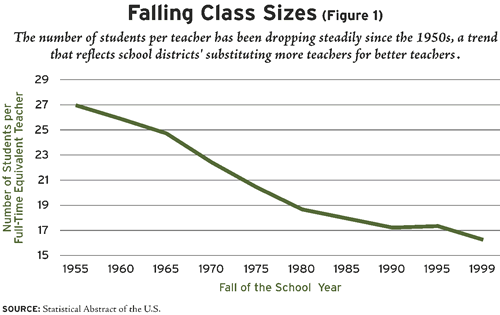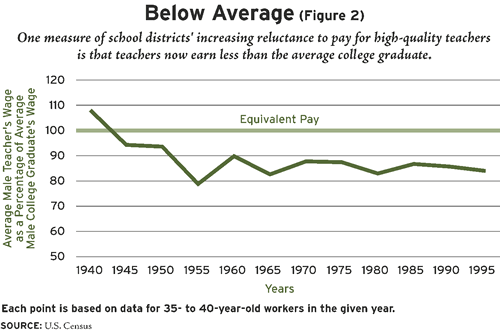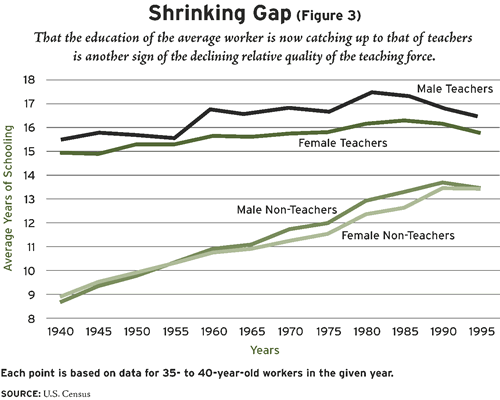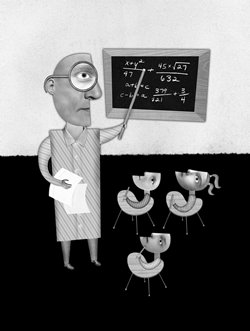 |
| Illustration by Joyce Hesselberth.
|
In a recent Public Agenda survey, parents of public high-school students supported the idea that reducing class sizes was a better way to improve schools than raising salaries for teachers. More stunning, however, was the survey’s finding that public high-school teachers felt the same way. This widespread support for class-size reduction has translated into legislative action at the state and federal levels. As early as 1984, Texas placed a cap of 22 students on classes in the early grades. Within the next 12 years, Nevada, Virginia, California, Indiana, and Tennessee followed suit. Efforts at the state level have been supported by the Clinton administration’s class-size reduction program, passed in 1998, which was to fund the hiring of around 29,000 new teachers during the 1999-2000 school year alone. While the Bush administration has retreated somewhat, its “No Child Left Behind Act” does provide states with block grants that can be used for class-size reduction.
With so much activity surrounding the issue of class size, one would think that the American education system were facing an unprecedented crisis of overcrowded classrooms and harried teachers. However, from a historical perspective, class-size reduction is a remedy in search of a problem. Between 1955 and 1995, the ratio of students to teachers in elementary and secondary schools fell from 26.6 to 15 students per teacher, a 40 percent decline (see Figure 1). The decline of the student/teacher ratio was steady across the 40-year period; moreover, as economists Eric Hanushek and Steven Rivkin have found, it was mainly growth in the pool of mainstream teachers, rather than those of administrators or special-education teachers, that accounted for the decline.
In fact, the real crisis seems to lie not in swelling class sizes, but in teachers’ dwindling relative pay. Male teachers born around 1900 could expect to earn 45 percent more than the average worker; by contrast, those born around 1950 could expect to earn 8 percent less. Female teachers experienced an even larger decline in their relative pay. In the past half century, schools appear to have shifted their resources into hiring more teachers and paying them lower salaries.
How to explain such relentless reductions in class size, especially when they seem to be at the expense of teacher pay? My research suggests that the trends in teacher quantity and pay are driven by the nature of technological progress in the larger economy. To understand how this might work, suppose that the knowledge used by skilled workers outside teaching, such as doctors or engineers, is improving as a result of innovation. This would raise the productivity of skilled nonteachers, thereby raising the price of skilled labor. However, suppose that the general knowledge transmitted by schoolteachers, such as reading or arithmetic, remains largely unchanged and that the productivity of teachers remains constant as a result. Now schools must pay higher prices for skilled teachers, but they do not receive higher productivity in return. Faced with this situation, schools will respond by lowering the quality of teachers relative to workers in other professional occupations and raising the quantity of teachers employed. The relative quality of teachers falls precisely because the economy is healthy enough to drive up the demand for educated workers. In a sense, high teacher quality inevitably becomes a victim of its own educational successes.
According to this theory, the declining relative pay of teachers reflects a concurrent decline in relative teacher quality. As teacher quality becomes more expensive, schools use less of it. Reducing class size emerges as a cheaper way to boost achievement than raising teacher quality.
This also helps to explain a puzzling feature of U.S. achievement data in the postwar period. Since teaching seems to be skill-intensive, the increase in the relative price of skilled workers has raised the overall cost of education. This may be why real costs per student have increased substantially (nearly doubling in the past 30 years) while the performance of schools, as measured by average student achievement, has not risen at all.
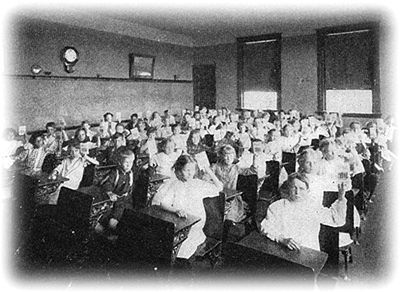 |
| From a historical perspective, class-size reduction is a remedy in search of a problem. Photograph from Public School Reports Collection, Gutman Library Special Collections/Harvard Graduate School of Education.
|
Stagnant Productivity
A great deal of research by labor economists has shown that the U.S. economy’s demand for skilled workers seems to have risen quite consistently since 1960, affecting workers of all ages. The steady growth in demand drove up the price of skilled workers in every decade except the 1970s, which witnessed an unusual increase in the supply of available college graduates. It is possible that the price of skilled workers has been growing for a much longer stretch of history. In a 1996 study, Claudia Goldin and Lawrence Katz provided evidence suggesting that the period from 1910 to 1940 witnessed substantial growth in the demand for skilled workers. Indeed, according to a 1992 study by Goldin and Robert Margo, the only decade of the 20th century that may have witnessed relative growth in the demand for unskilled workers was the 1940s.
However, overall growth in the demand for skilled workers is not enough to explain the trends in education; there must have been less growth in the demand for skilled teachers as well. In particular, it must be true that today’s college-educated teacher is no more productive than yesterday’s. The economist William Baumol, in a 1967 article, was perhaps the first to argue that productivity growth is slower in education. Several pieces of indirect evidence make this idea seem reasonable. In a 2001 study, Robert Strauss and William Vogt found that the productivity of teachers is driven primarily by their knowledge of subject matter rather than of pedagogical techniques. If true, this suggests that productivity growth in education would tend to involve advances in knowledge rather than in teaching techniques.
Advances in knowledge may be possible for secondary-school teachers. For instance, high-school biology students may learn more genetics than they used to. However, the nature of educating young children makes advancement difficult in the early grades. All children must learn to read, write, and do arithmetic, yet every generation begins as a blank slate. Moreover, it appears unlikely that children are learning more in their preschool years: in a 1989 study, John Bishop found that the IQ scores of American five-year-olds have remained fairly constant during the post-World War II period. By this logic, the productivity of elementary-school teachers has remained fairly constant. This may also be true of many secondary-school teachers, especially in disciplines that tend not to change over time, such as the humanities.
As the demand for and prices of skilled workers rise, industries outside education are willing to pay the higher price, which is justified by higher productivity. If the assumptions about productivity in the education realm are correct, however, schools face a higher price for skilled workers even though skilled teachers are no more productive than they used to be. As a result, schools will be more reluctant to hire skilled teachers. Over time, a significant number of skilled workers will flow out of education and into other industries. The quality of teachers will decline relative to the quality of workers in other knowledge-intensive industries.
The rising price of skill means that it is cheaper for schools to improve education by lowering class sizes than by attracting more skilled teachers. Schools will thus compensate for the loss of skilled teachers by reducing class sizes. This helps to understand the long-standing and continuing push for smaller classes in the United States. Finally, although schools can compensate in part for the loss of skill, they still face higher prices for labor than in the past. This will inevitably raise the per-pupil cost of providing an education. Ultimately, the increased per-pupil cost of schooling is caused by growth in the demand for educated workers.
Measuring Relative Quality
The theory offered here implies that the decline in teachers’ relative pay reflects a real decline in their relative quality. Indeed, in my research, all the measures of quality reveal that the quality of teachers has declined relative to that of other workers and of other skilled workers. First, using years of school as a measure of quality, it appears that the education level of teachers has declined relative to the schooling of other workers, no matter how skilled. Second, wage-based measures of quality suggest that the wages of teachers relative to those of other workers have fallen considerably, even after accounting for other factors that may not be related to quality. Finally, several alternative explanations for falling relative quality do not fit all of the empirical facts as well as the theory presented in this research.
There is no perfect measure of quality, but schooling and wages do represent reasonable ways to investigate it, for several reasons. Let’s assume that teachers’ quality is equivalent to their productivity. If further training, such as a master’s degree or Ph.D., transmits productive skills, better-educated workers will also be more productive. Moreover, since more productive workers are more highly valued, they will also tend to be paid more. This relationship will hold true in education regardless of whether schools are run efficiently. As long as workers are paid in accordance with their productivity—and their education—in other sectors of the economy, schools will have little choice but to follow suit. In the long run, if teachers are not paid in accordance with their productivity, many will leave teaching, and similarly productive workers will choose not to enter the profession.
Schooling as a measure of quality. Figure 3 illustrates the trends in schooling most simply. Based on data from the 1940-1990 U.S. censuses, it depicts the average years of schooling possessed by a male or a female teacher compared with the average male or female nonteacher. In the course of the 20th century, there was a steady and fairly rapid decline in teachers’ amount of additional schooling. Teachers born at the beginning of the century had roughly six or seven more years of schooling than their nonteaching counterparts, but those born in the middle of the century had only two to three years more education than their peers. During this period, male and female teachers gained about 0.9 years of schooling, while other workers gained about 4.7 years. Significantly, this downward trend has been quite similar for male and female teachers. This suggests that the demand for skill outside teaching has been growing for both males and females. In other words, the expansion in demand for skilled women outside teaching is not in itself enough to explain the observed declines in quality, as discussed below.
So far, the schooling of teachers has been compared only with that of all other workers. Small gains in the education of teachers relative to other workers may not be evidence of declining quality, however; additional years of schooling may be more valuable for teachers because, as highly skilled workers, they face higher opportunity costs of staying out of the labor force. Forgoing a year in the labor force is much costlier for a college graduate than a high-school dropout because the college graduate has more lucrative job opportunities. Therefore, small increases in the schooling of teachers may be just as valuable (and costly) as larger increases in the schooling of the average worker.
Ideally, therefore, teachers should be compared with workers who start out similarly skilled. To carry out this comparison, I ranked all the occupations of men born between 1900 and 1909 in terms of average schooling. I then picked out the occupations most similar to teachers in this respect. These turned out to be: airplane pilots and navigators, architects, chemists, chiropractors, professors, dentists, chemical engineers, electrical engineers, mechanical engineers, metallurgical engineers, farm and home management advisors, lawyers and judges, librarians, optometrists, osteopaths, pharmacists, and physicians and surgeons. From this set of occupations, I created a single, composite skilled occupation, computed the average schooling for this occupation, and compared that with the average schooling of teachers.
Teachers lost considerable ground from the 1900 to the 1955 birth cohorts, even compared with this finely chosen set of occupations. While the composite of other occupations gained 1.5 years of schooling, teachers gained slightly less than 1 year. The relative decline is even more striking when the proportion of workers with post-college education (defined as having 17 or more years of schooling) is compared. In 1900, 38 percent of both teachers and the composite occupation possessed some form of post-college education. By 1955, however, rates of post-college attainment were more than 50 percent lower for teachers. The proportion rose by more than 20 percentage points for the composite occupation, but actually declined slightly for teachers.
Wages as a measure of quality. The pay of teachers has not kept pace with the pay of other workers. This provides further evidence that their productivity has not kept pace either. The simplest way to see this is to investigate how the status of teachers has changed compared with that of other wage earners. Teachers born around 1900 could expect to find themselves near the top quartile of the earnings distribution, but teachers born half a century later could expect to find themselves at the median. Female teachers have fallen by roughly 15 percentage points in the earnings distribution, while male teachers have slid nearly 20 percentage points.
Multivariate analyses of the data on wages, schooling, and individual characteristics reveal this striking fact: the relative wage of a teacher born in 1900 was higher than that of a teacher born in 1950, even if the two teachers are of the same age and years of experience. I calculated a range of estimates for the share of this decline that can be attributed to changes in quality—as opposed to changes in experience or changes in market conditions for teachers. The middle estimates show that the “quality based” relative wage declined by about 15 percent for men and 20 percent for women. This means that, among women, the value of teachers’ skills has grown by 15 percentage points less than the value of nonteachers’ skills. Even on the basis of wildly optimistic assumptions about improvement in the quality of teachers, the quality-based wage declined by 6 percent for women and 3 percent for men. In other words, the difference in wages cannot be attributed to differences in experience or to temporary changes in the demand for teachers. This result suggests that there are real differences in quality between the 1900 and the 1950 birth cohorts.
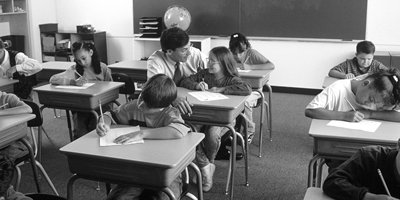 |
| The real crisis seems to lie not in swelling class sizes, but in teachers’ dwindling relative pay. Photograph from Comstock Images.
|
Understanding the Alternatives
Let’s consider some alternative explanations of the trends in class size and teacher pay. In the past half century, one of the most significant changes in the labor market for teachers has been the development of serious opportunities for skilled women outside teaching. Nearly half of all working women with 14 or more years of schooling in the 1900 birth cohort were teachers. By the 1955 birth cohort, this proportion had fallen to 10 percent. The increasing availability of alternatives has bid up the price of skilled women. While this can explain falling class sizes and the declining quality of female teachers, it cannot account for the decline in the quality of male teachers. In the absence of overall growth in the demand for skilled workers outside teaching, increasing opportunities for women outside teaching would occur at the expense of skilled men, lowering the price of skilled males and raising the relative quality of male teachers. In fact, however, both male and female teachers have less schooling and have experienced declines in wages.
The economist Caroline Hoxby’s model of a “rent seeking” teacher union offers another plausible explanation of the broader trends in pay and class size. Suppose that teacher unions value smaller classes because they are more pleasant to work in and because they add members to the union’s ranks. Then suppose that they do not value teachers of high quality, perhaps because they make other teachers look bad in comparison. This could explain falling quality and class sizes and rising per-pupil costs. This may have been an important factor in recent years, but rising costs and falling class sizes pre-date widespread unionization. Teacher unions were largely powerless (if they existed at all) before 1960. As late as 1972, only 14 percent of school districts had a majority of unionized teachers with a collectively bargained wage agreement. However, from 1950 to 1970, class sizes fell by 20 percent. Hanushek and Rivkin have shown that real per-pupil spending began to grow in 1920 and that growth accelerated sharply in the 1960s, before unions had become entrenched. My research shows that declines in teacher quality also pre-date unions.
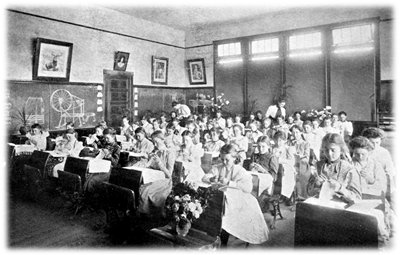 |
| Declines in the relative quality of teachers, reductions in class size, and growth in per-pupil spending can all be traced to the same source—growing demand for skilled workers outside education. Photograph from Gutman Library Special Collections/Harvard Graduate School of Education.
|
Another set of explanations involves the influence of public policy. One possibility is that the rigidity of public sector budgets or wage schedules causes schools to mechanically hire teachers of lower quality when the price of skill rises. However, this dynamic would cause the quality of all public sector employees to decline—a trend not supported by the data. In terms of schooling, one of our measures of worker quality, the education levels of nonteaching males in the public sector have not declined relative to the education levels of other male workers. Moreover, the similarity of trends in public and private schools casts doubt on explanations that emphasize the failure of public schools to match growth in parental demand for teacher quality. If public schools are failing to give parents what they want, private schools might step into the void. However, the quality of private school teachers has also been declining substantially. From the 1900 to 1950 birth cohorts, female private school teachers lost about three years of schooling—exactly the amount of schooling lost by female teachers overall. The pattern for male teachers is similar. Furthermore, the decline in the quality-based relative wage is similar for public and private school teachers.
Another criticism might be that teachers’ wages are not an appropriate measure of quality. Public policy and unionization may have severed the link between the skill of teachers and their wages or schooling; teachers may be as capable as ever. But more direct evidence on teachers’ skills confirms the findings regarding wages. Using data from the National Longitudinal Surveys, Marigee Bacolod found that from the 1941-45 birth cohort to the 1963-64 birth cohort, the share of teachers scoring above the 80th percentile on the Armed Forces Qualifying Test fell from 50 percent to 10 percent for women and from 20 percent to 10 percent for men. By contrast, the proportion rose from 30 percent to 60 percent for female nonteaching professionals and from 60 percent to nearly 80 percent for male nonteaching professionals. Moreover, as mentioned above, the quality of teachers in private schools has also declined. Since private schools are barely influenced by public policy or unionization, this indicates that there are stronger market forces at work.
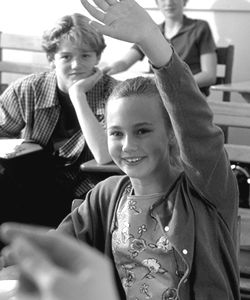 |
| Finding evidence that reduction in class size raises student achievement has often been difficult. Photograph by Comstock Images.
|
Conclusion
The research summarized here contends that declines in the relative quality of teachers, reductions in class size, and growth in per-pupil spending can all be traced to the same source—growing demand for skilled workers outside education. This interpretation of the evidence has important implications for education policy. Although the quality of schoolteachers appears to be falling, this may not compromise the position of today’s students. Changes in market conditions have simply altered the efficiency of various educational inputs. This causes resources to flow away from teacher quality and toward other, more productive uses within the education system. Perhaps the most important point, however, is that these trends are themselves generated by growth in the demand for educated workers. Therefore, the apparent “failure” of schools to maintain teacher quality is just a symptom of education’s success.
The decline in teachers’ quality has been accompanied by growth in the teacher-to-student ratio. This points to another important lesson: one cannot evaluate the quality of the education system by simply measuring changes in one set of inputs, such as the quality of teachers. A decline in one set of education inputs may be accompanied by growth in another set; similarly, a decline in output as a result of one change may be accompanied by growth in output as a result of another. The only reliable way to assess the quality of the education system is to measure the quality of the workers who have graduated from it. This view would assign less importance to concerns about declining test scores at the elementary-school level, since the increasing skill of the workforce provides evidence that overall student achievement is not falling. These declines may simply point to the rising cost of producing human capital at the elementary-school level. One of the most controversial areas of education research concerns the effects of class size, and of school resources more generally, on student achievement. Finding evidence that reduction in class size raises student achievement has often been difficult. In fact, some researchers argue that there is no real effect at all. The theory presented here suggests one reason why it has been so difficult to find an effect. Nonexperimental variation in class sizes may be correlated with the quality of teachers and vice-versa. Schools with smaller classes may have lower quality teachers, and it will be quite difficult to disentangle these two effects.
Not every apparent ill of the education system demands or is amenable to a policy solution, and the declining relative quality of teachers provides an excellent example. In the end, the most effective way to maintain teacher quality would be to squelch the growth in the demand for educated workers outside education—a modest proposal, to say the least.
-Darius Lakdawalla is an associate economist at the RAND Corporation in Santa Monica, California.


